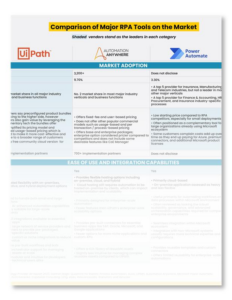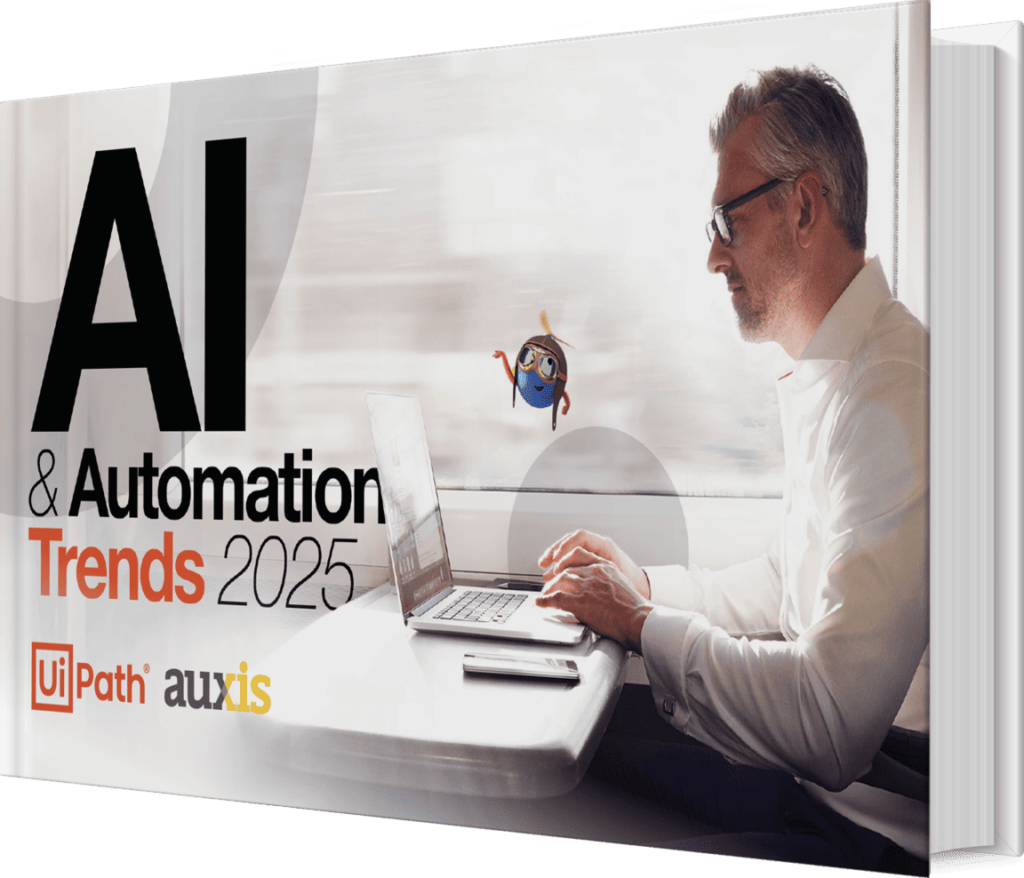In brief:
- Robotic Process Automation (RPA) isn’t “set it and forget it.” Process changes and UI updates inevitably break automations.
- RPA talent shortages hurt results. 50% of organizations cite lack of technical talent as their biggest automation roadblock.
- Developers aren’t support teams. Relying on them strains resources, slows innovation, and increases downtime.
- Avoiding 4 common RPA support and maintenance mistakes is key to success. Specialized support teams keep bots running smoothly and improve performance.
Robotic Process Automation (RPA) forever changed the way modern enterprises manage critical business processes. But robots are never a “set it and forget it” investment – and too many initiatives fall apart because companies overlook proactive RPA support and maintenance as the secret to sustainable success.
RPA offers a game-changing ability to automate repetitive, rule-based tasks and functions, but without ongoing monitoring and support, even simple workflows can fail when systems change. But many business leaders don’t realize that robots are trained to specific user interfaces (UI), and therefore can’t adapt when something unexpected inevitably occurs, such as updates to an external application.
Frequent break-fix cycles that repeatedly take bots out of production drive up costs, reduce productivity, and disrupt customer service. They eat into RPA ROI and the program’s broader business objectives. They also cause organizational confidence in the technology to wane.
A well-structured, dedicated robotic process automation support and maintenance team that can guarantee consistent operation of your bots is critical to achieving long-term automation value and improving operational efficiency. Here are the 4 biggest reasons organizations are getting RPA and support maintenance programs wrong – and how you can get it right:
Mistake #1: Assigning RPA support and maintenance to the development team
Too many organizations neglect to create a separate RPA production support structure, wrongly assuming their developers will act as emergency response teams for their bots. But ongoing RPA maintenance and support requires a different set of skills than design and implementation.
Many companies also underestimate the amount of ongoing support required as their program scales, distracting developers from innovating and slowing their enterprise-wide agenda. This is especially true as automation expands beyond rule-based tasks into more complex, cross-functional processes.
Conversely, prioritizing new RPA developments delays maintenance activities – ultimately increasing downtime and decreasing cost savings. Turnover also tends to increase when high-value resources are forced to perform monotonous, repetitive tasks. Developers rank maintaining existing bots — alongside creating documentation and testing RPA solutions — as among their least-favorite automation tasks, according to UiPath’s 2024 State of the Automation Professional Report.
Segregating your development and support teams also boosts automation quality. Not only does handing off support force developers to utilize a standardized development framework that anyone can follow, but it also creates a mechanism for quality control before automations go live.
Mistake #2: Underestimating the RPA talent shortage
Unfortunately, building a separate support team in-house faces an imposing obstacle: the severe RPA talent shortage in the U.S.
Automation resiliency requires more than an ability to perform updates, continuous monitoring, and quick troubleshooting. High-quality support teams also have the expertise to improve automated processes by proactively identifying bottlenecks with tools like process mining and other analytics.
Additionally, inexperienced resources often struggle to support bots effectively, causing weak automation stability and extended outages.
However, the rapidly advancing nature of automation technology — combined with the talent shortage — makes it difficult to hire quality resources.
Nearly 50% of attendants at a recent Auxis webinar ranked lack of technical talent as the biggest stumbling block to realizing value from their AI and automation programs.
Competition for talent familiar with the market-leading UiPath platform is particularly fierce, as UiPath’s popularity prompts more companies to fight for limited resources. More than 80% of organizations planned to hire more automation professionals in 2025, the UiPath report found.
With demand drastically outweighing supply, employers attempting to staff RPA support teams are paying a premium. As of June 2025, the U.S. tech unemployment rate dropped to 2.8%, significantly lower than the overall unemployment rate of 3.8%, with emerging technologies such as intelligent automation, artificial intelligence, and cybersecurity accounting for about a third of all open tech positions.
Retention is another critical issue, with about 40% of automation developers planning to leave their current role, UiPath found. RPA solution support teams tend to experience exceptionally high turnover as resources look to leverage their experience into more innovative, higher-paying development roles.
Mistake #3: Relying on reactive, manual processes
It’s no secret that scaling automation remains a challenge for many enterprises. Building a strong RPA maintenance and support team is integral to getting it right.
But in the excitement of getting RPA bots up and running, ongoing maintenance is often overlooked and suffers from underinvestment. Without a structured support program, RPA solution teams are forced into crisis mode when bots break as they scramble to minimize business impact and restore functionality.
Getting RPA bots back online quickly is also essential to the success of your automation program, preventing frustrated workers from abandoning digital systems and reverting to manual tasks. Unfortunately, the diagnostic work required to understand where and why an error occurred on the fly does little to limit downtime.
A dedicated team focused solely on support has the bandwidth to keep up with proactive maintenance tasks as the number of automations grows. They are experts at mitigating the risk of outages by anticipating how system or regulatory changes will impact business processes.
Without other distractions, they can also focus on implementing best practices and repeatable processes that enable support services to scale with your RPA journey. For example, monitoring bot health is essential for proactively reducing outages and pinpointing the root causes of problems by tracking metrics such as the number of incidents per automation, types of incidents, and the time taken for evaluation and resolution.
Exceptional RPA maintenance and support teams also utilize key RPA technology enablers geared toward moving organizations from reactive to proactive support. For instance, the UiPath platform offers:
- UiPath Automation Suite, with mechanisms for clear governance, issue management, tracking open issues, and measuring and reporting SLAs.
- UiPath Insights, combining data modeling and analytics that use available business metrics and operational insights to track performance indicators and alert teams to errors.
- UiPath Test Suite, enabling continuous, automated testing that resolves defects faster by ensuring every requirement is fully tested before deployment or scheduled runs.
- UiPath Healing Agent, providing an ability to identify issues like a new pop-up, recommend corrective actions, and apply fallback strategies to keep the automation running. For example, the agent can write suggested code changes, which are then sent to developers for validation and, if approved, on to production.
Mistake #4: Treating every RPA solution equally
Business continuity is an RPA maintenance and support team’s #1 priority. And some automated business processes are more impactful than others to your business.
This is particularly true as automation expands into more complex tasks or becomes part of AI-driven workflows. For instance, a bot that breaks while handling invoice processing with payables stretching for 90 days causes less pain than a bot that stops processing orders, impacting revenue directly.
Quality support demands a mechanism for assessing automation failures, and prioritizing response based on business impact and how urgently a resolution or workaround is needed.
For instance, a good SLA for Priority 1 incidents in the chart below requires a response within 30 minutes and assessment in less than one hour. Requirements for resolution times are typically based on incident type: infrastructure and access incidents can typically be resolved within two hours, while incidents triggered by application updates will depend upon the scope of the change.
.jpg)
Since process exceptions are inevitable, setting clear expectations upfront with the business about potential downtime during incidents is integral to a successful RPA journey. It is also important to minimize business pain by developing contingency plans for managing outages with impactful processes.
Why Auxis: The solution for effective RPA support and maintenance
There’s no one-size-fits-all model for a scalable RPA maintenance and support structure. Key factors like organizational size, number of automations, and whether RPA is core to your competencies will determine if an in-house, outsourced, or hybrid approach makes sense.
However, even organizations that keep RPA development in-house are increasingly outsourcing support to nearshore managed service providers – gaining dedicated real-time support for urgent issues, faster time to benefit, and reduced risk. This ensures bots are monitored and maintained effectively.
In fact, 59% of Latin American shared services now deliver intelligent automation services – more than double the global average, according to the 2024 State of the GBS and Outsourcing Industry in Latin America report by the Shared Services & Outsourcing Network (SSON) and Auxis.
As a UiPath Platinum Partner and Partner of the Year, Auxis understands that RPA support and maintenance can’t be an afterthought – it’s a key driver of automation ROI.
With decades of IT operations expertise and mature network operations center (NOC) capabilities, Auxis stands out from providers who monitor manually – enabling 24/7 scalable support, automated incident management, and intelligent infrastructure monitoring. Its dedicated Support Center of Excellence further leverages a nearshore and onshore delivery model to ease the talent challenge and boost cost savings.
A dedicated RPA support and maintenence team — within your same time zone — sets the course for smooth sailing in your intelligent automation journey. The result: the ability to scale with confidence and keep your automation solutions operating at peak performance.
To learn more about how Auxis can help you set up an effective and proactive RPA support model, schedule a consultation with our RPA experts. Or visit our resource center for more intelligent automation, machine learning, and RPA tips, strategies, and success stories.
Frequently Asked Questions
1. What are the common causes of RPA bot failures, and how can maintenance help prevent them?
2. Why can’t my RPA developers provide effective RPA support and maintenance for my bots?
3. How does outsourcing RPA support and maintenance improve bot performance and reduce downtime?
What metrics should companies track to effectively monitor the health of their robotic process automation bots?




